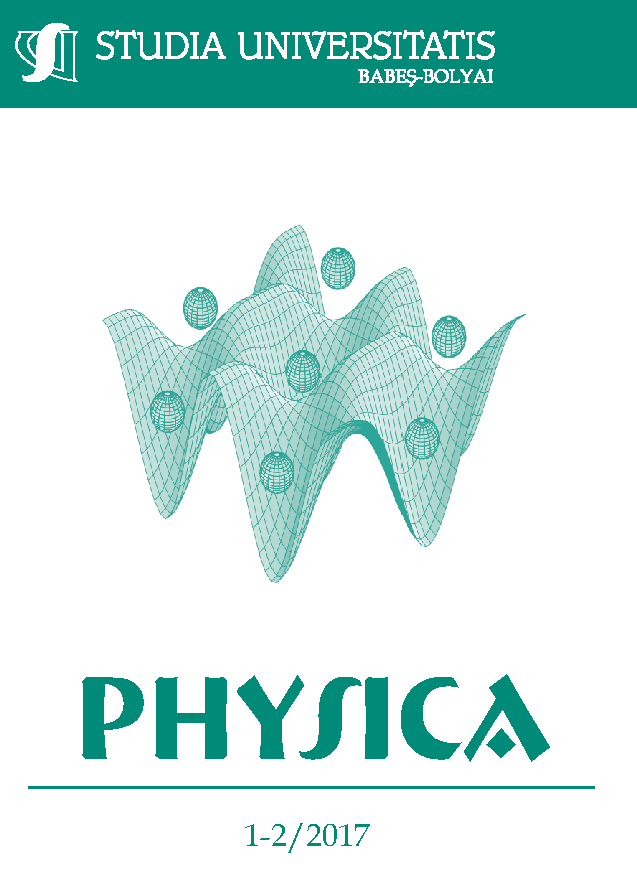CONFORMATIONAL SPACE AND ELECTRONIC ABSORPTION PROPERTIES OF THE TWO ISOMERS OF RESVERATROL
DOI:
https://doi.org/10.24193/subbphys.2017.05Keywords:
trans-resveratrol; cis-resveratrol; conformational analysis; UV-VISAbstract
The present study analyses the trans and cis conformations of resveratrol, aiming to get clear experimental and computational evidences that can be used to differentiate between the two isomers. Three conformers for each isomer have been considered and their characteristic geometrical parameters, relative free energies, Boltzmann populations and electronic transitions have been calculated at B3LYP/6-31+G(2d,2p) level of theory in gas phase, as well as in water, ethanol and DMSO. The experimental UV-Vis spectra of the two isomers have been explained by using the time dependent density functional theory (TD-DFT) formalism.References
J. Gusman, H. Malonne, and G. Atassi, “A reappraisal of the potential chemopreventive and chemotherapeutic properties of resveratrol,” Carcinogenesis, 22 (2001) 1111–1117.
S. Quideau, D. Deffieux, and L. Pouységu, “Resveratrol Still Has Something To Say about Aging!,” Angew. Chem. Int. Ed., vol. 51, no. 28, pp. 6824–6826, Jul. 2012.
R.Á. Rodríguez, I.R. Lahoz, O.N. Faza, M.M. Cid, and C.S. Lopez, “Theoretical and experimental exploration of the photochemistry of resveratrol: beyond the simple double bond isomerization,” Org. Biomol. Chem., vol. 10, no. 46, pp. 9175–9182, Nov. 2012.
M. Diaz, H. Degens, L. Vanhees, C. Austin, and M. Azzawi, “The effects of resveratrol on aging vessels,” Exp. Gerontol., vol. 85, no. Supplement C, pp. 41–47, Dec. 2016.
J. Park and Y.C. Boo, “Isolation of Resveratrol from Vitis Viniferae Caulis and Its Potent Inhibition of Human Tyrosinase,” Evidence-Based Complementary and Alternative Medicine, 2013. [Online]. Available: https://www.hindawi.com/journals/ecam/ 2013/645257/. [Accessed: 13-Dec-2017].
S. Renaud and M. de Lorgeril, “Wine, alcohol, platelets, and the French paradox for coronary heart disease,” Orig. Publ., Vol. 1, Issue 8808, vol. 339, no. 8808, pp. 1523–1526, Jun. 1992.
T.S. Figueiras, M.T. Neves-Petersen, and S.B. Petersen, “Activation energy of light induced isomerization of resveratrol,” J. Fluoresc., vol. 21, no. 5, pp. 1897–1906, Sep. 2011.
F. Caruso, J. Tanski, A. Villegas-Estrada, and M. Rossi, “Structural Basis for Antioxidant Activity of trans-Resveratrol: Ab Initio Calculations and Crystal and Molecular Structure,” J. Agric. Food Chem., vol. 52, no. 24, pp. 7279–7285, Dec. 2004.
Gaussian 09, Revision E.01, M.J. Frisch, G. W. Trucks, H. B. Schlegel, G. E. Scuseria, M. A. Robb, J. R. Cheeseman, G. Scalmani, V. Barone, G.A. Petersson, H. Nakatsuji, X. Li, M. Caricato, A. Marenich, J. Bloino, B.G. Janesko, R. Gomperts, B. Mennucci, H.P. Hratchian, J.V. Ortiz, A.F. Izmaylov, J.L. Sonnenberg, D. Williams-Young, F. Ding, F. Lipparini, F. Egidi, J. Goings, B. Peng, A. Petrone, T. Henderson, D. Ranasinghe, V.G. Zakrzewski, J. Gao, N. Rega, G. Zheng, W. Liang, M. Hada, M. Ehara, K. Toyota, R. Fukuda, J. Hasegawa, M. Ishida, T. Nakajima, Y. Honda, O. Kitao, H. Nakai, T. Vreven, K. Throssell, J.A. Montgomery, Jr., J.E. Peralta, F. Ogliaro, M. Bearpark, J.J. Heyd, E. Brothers, K.N. Kudin, V.N. Staroverov, T. Keith, R. Kobayashi, J. Normand, K. Raghavachari, A. Rendell, J.C. Burant, S.S. Iyengar, J. Tomasi, M. Cossi, J.M. Millam, M. Klene, C. Adamo, R. Cammi, J.W. Ochterski, R.L. Martin, K. Morokuma, O. Farkas, J.B. Foresman, and D. J. Fox, Gaussian, Inc., Wallingford CT, 2016.
A.D. Becke, “Density‐functional thermochemistry. III. The role of exact exchange,” J. Chem. Phys., vol. 98, no. 7, pp. 5648–5652, Apr. 1993.
C. Lee, W. Yang, and R.G. Parr, “Development of the Colle-Salvetti correlation-energy formula into a functional of the electron density,” Phys. Rev. B, vol. 37, no. 2, pp. 785–789, Jan. 1988.
S.H. Vosko, L. Wilk, and M. Nusair, “Accurate spin-dependent electron liquid correlation energies for local spin density calculations: a critical analysis,” Can. J. Phys., vol. 58, no. 8, pp. 1200–1211, Aug. 1980.
W.J. Hehre, R. Ditchfield, and J.A. Pople, “Self—Consistent Molecular Orbital Methods. XII. Further Extensions of Gaussian—Type Basis Sets for Use in Molecular Orbital Studies of Organic Molecules,” J. Chem. Phys., vol. 56, no. 5, pp. 2257–2261, Mar. 1972.
M.J. Frisch, J.A. Pople, and J. S. Binkley, “Self‐consistent molecular orbital methods 25. Supplementary functions for Gaussian basis sets,” J. Chem. Phys., vol. 80, no. 7, pp. 3265–3269, Apr. 1984.
M.E. Casida, C. Jamorski, K.C. Casida, and D.R. Salahub, “Molecular excitation energies to high-lying bound states from time-dependent density-functional response theory: Characterization and correction of the time-dependent local density approximation ionization threshold,” J. Chem. Phys., vol. 108, no. 11, pp. 4439–4449, Mar. 1998.
R.L. Martin, “Natural transition orbitals,” J. Chem. Phys., vol. 118, no. 11, pp. 4775–4777, Feb. 2003.
J. Tomasi, B. Mennucci, and R. Cammi, “Quantum Mechanical Continuum Solvation Models,” Chem. Rev., vol. 105, no. 8, pp. 2999–3094, Aug. 2005.
A.J. Cohen, P. Mori-Sánchez, and W. Yang, “Challenges for Density Functional Theory,” Chem. Rev., vol. 112, no. 1, pp. 289–320, Jan. 2012.
A.E. Clark, “Time-Dependent Density Functional Theory Studies of the Photoswitching of the Two-Photon Absorption Spectra in Stilbene, Metacyclo¬phenadiene, and Diarylethene Chromophores,” J. Phys. Chem. A, vol. 110, no. 10, pp. 3790–3796, Mar. 2006.
Downloads
Published
How to Cite
Issue
Section
License
Copyright (c) 2017 Studia Universitatis Babeș-Bolyai Physica

This work is licensed under a Creative Commons Attribution-NonCommercial-NoDerivatives 4.0 International License.






